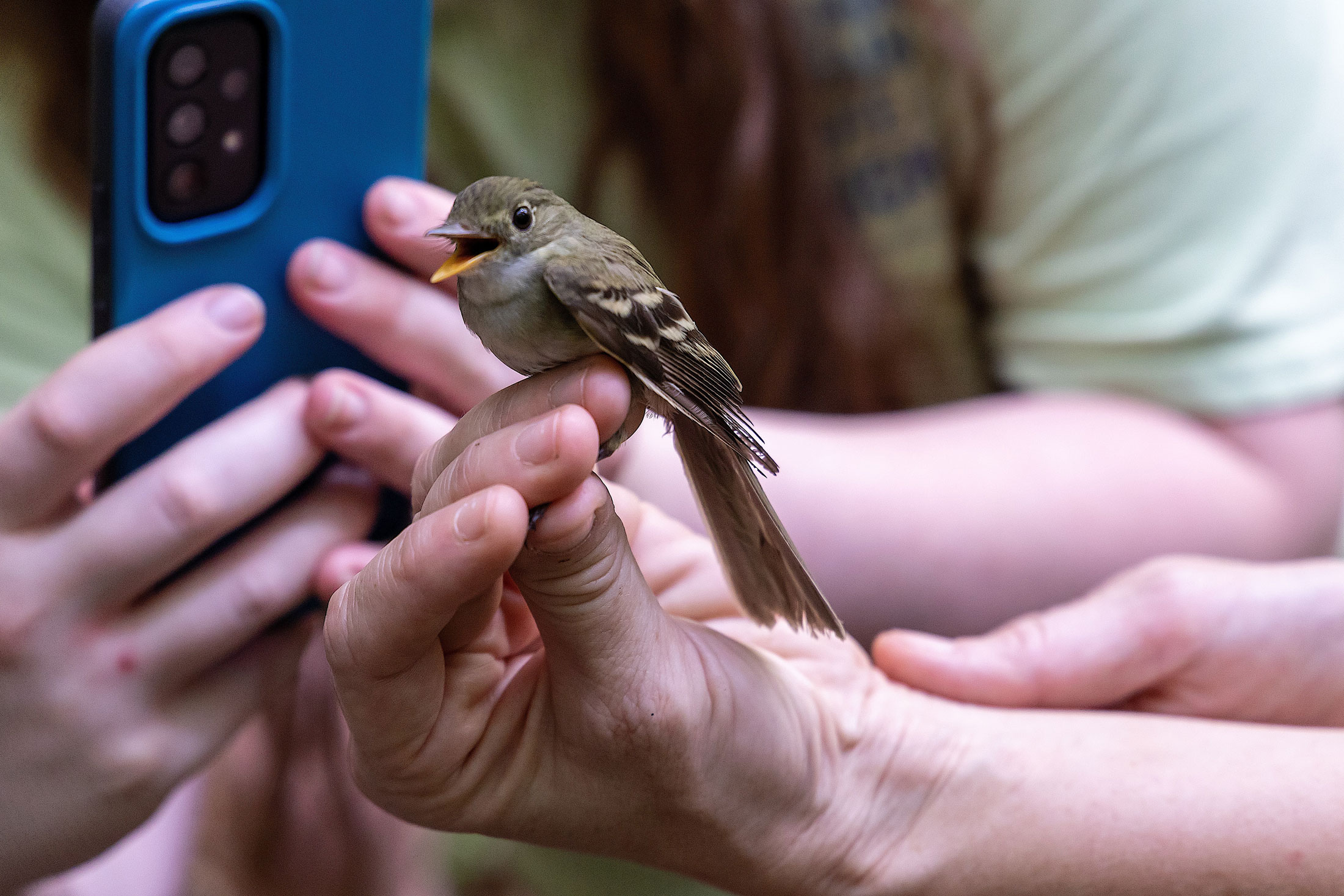
You never know what you’ll find in a mist net. As they made the rounds one June morning this year, researchers at the Great Smoky Mountains Institute at Tremont in Great Smoky Mountains National Park were surprised to find a female Kentucky warbler waiting in the webbing.
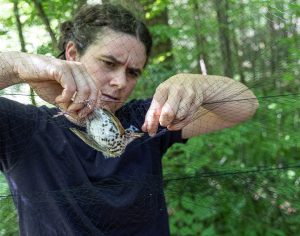
Measuring about six and a half feet high and nearly 40 feet long, these nets are made of fine mesh and used by researchers to capture otherwise hard-to-come-by data on a site’s bird population. Working with licensed bird banders, Tremont regularly deploys 13 such nets as part of Monitoring Avian Productivity and Survivorship, or MAPS, a continent-wide effort to learn more about breeding bird populations.
“There is information that can be easily gotten from birds without ever having to touch them, such as identifying them to species, but there are a few things that can only be learned if one briefly has them in the hand,” said Paul Super, a licensed bird bander and science coordinator for the park.
If the Kentucky warbler hadn’t gotten caught in the net, scientists may have never known that species was present at Tremont. The female warbler had a brood patch—an area of featherless skin that means she’s currently raising young and that a male Kentucky warbler is likely nearby. Breeding males are typically rather vocal, but nobody had seen or heard one there prior to the capture. Finding the female was “quite a surprise,” Super said.
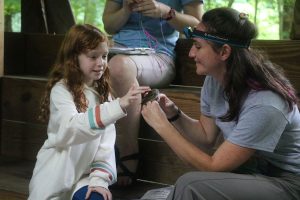
Though Kentucky warblers are relatively common across their range, they’ve become rare in the park, likely because their preferred habitat—forest with brushy understory—is declining in the Smokies. This was the first time the MAPS station had ever recorded a Kentucky warbler, exemplifying why mist netting is such an important tool for understanding bird populations. The park also participates in two annual breeding-bird surveys in which scientists stop every half mile or so, recording all the birds they hear or see in that spot before moving on. Roughly 40 sites are documented during each survey. These results help scientists understand how abundance is changing in different bird species. No Kentucky warblers have been recorded on these surveys “for a long time,” Super said.
“But if you want to be sure you know what’s going on with birds, you should be monitoring them in multiple ways,” he said.
According to Tremont Education Director John DiDiego, understanding these details about local bird populations can lead to scientific findings of global importance. Some migratory birds that breed in the Smokies have enormous ranges and spend their winters as far south as Argentina, making them “bellwether species” for emerging environmental issues across the hemisphere. A 2019 research article drawing from several long-term datasets found that the number of birds in the United States and Canada has fallen by 29 percent since 1970, highlighting the impact of ongoing habitat loss in the Americas.
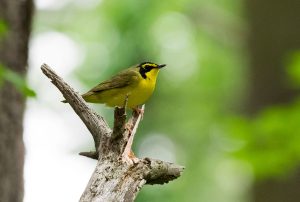
At the Tremont station, the Kentucky warbler is one of 42 species that have been recorded in the nets over the years. Louisiana waterthrushes account for about one-third of total captures on the site. It’s optimal habitat for them, and they spend most of their time close to the river, flying at the same altitude as the nets. Birds that live primarily in the canopy, such as blue-headed vireos and yellow-throated warblers, aren’t reflected in the MAPS data. The nets don’t reach high enough to catch them.
Common captures at the Tremont station include the Carolina wren, eastern phoebe, and wood thrush. Rarely, a cedar waxwing, belted kingfisher, or pileated woodpecker is recorded.
Each summer, the mist nets go up for six hours once every ten days, starting in the last ten days of May and ending in the last ten days of August. The nets are checked at regular intervals, and experienced “bird pluckers” untangle any snared birds from the mesh. Each bird is entered into a data sheet that records everything from the state of the bird’s plumage to how much fat it carries and whether it’s ready to breed. If it has a leg band, the number is noted. If not, a new one—a lightweight, aluminum band with a unique nine-digit number—is placed on its leg.
“If we recapture banded birds, it tells us how old the birds get at our site, whether we are a ‘starter home’ from which young birds are constantly leaving for an upgrade, or whether we are choice habitat,” Super said. “By marking the juvenile birds we catch and then seeing how often we recapture them, we can get a good idea of how successful these birds are at reproducing.”
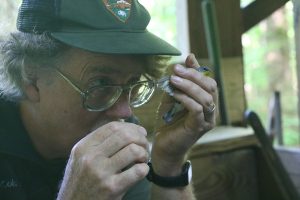
The MAPS site at Tremont has been running for 21 out of 25 summers since 2000 and averages 84 captures per year, which is on the low side compared to other MAPS stations in North America. It’s also low compared to the MAPS station that ran at Purchase Knob on the North Carolina side of the park from 2002 to 2007. That site averaged 320 captures per year, high compared to other stations. Staffing considerations forced the park to close it down.
While staffing continues to be a limiting factor for the park, the Tremont MAPS station benefits from the attention of park partner Great Smoky Mountains Institute at Tremont. For years, ornithologist and ace bird-bander Tiffany Beachy ran the banding station during her tenure as Tremont’s staff scientist. She left in 2018, and now Super is training Tyler Thomas, who was hired to the position this year, to take over those duties.
Tremont also works with a cadre of highly skilled volunteers and licensed bird banders from Seven Islands State Birding Park who ensure the nets are set up and data recorded on schedule. Meanwhile, participating in MAPS presents a valuable educational opportunity for kids attending field trips and summer camps hosted at the site, as well as for summer science interns who are early in their wildlife careers.
“Banding for those folks is a big deal,” DiDiego said. “They get some significant experience. By the end of the summer, they will have helped get birds out of nets and have more of a resume in terms of bird handling and doing data entry.”
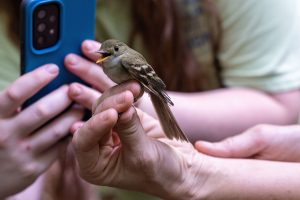
It’s also a big deal for kids, many of whom get the opportunity to hold a tiny songbird in their hands when visiting Tremont. “We’ve got so many pictures of little kids and families with young kids who just have this look of total incredulity in their eyes,” DiDiego said. “There’s this sense of wonder.”
When Tremont’s MAPS stations conclude their summer data collection later this month, it will mark the end of another season of contributing invaluable information about regional biodiversity to the international MAPS project. But beyond the fresh data and the excitement surrounding the Kentucky warbler capture, it’s the sense of wonder and curiosity inspired by Tremont’s educational programs that may have an even more lasting impact on the future of birds in the Smokies.
According to DiDiego, these are “magical” moments that participants young and old will remember for many summers to come.
“People don’t forget that moment that they were able to hold a bird in their hand and look into its eyes,” he said. “I think there’s just a supreme value in that connection.”
Subscribe to get the latest posts sent to your email.
The Great Smokies Welcome Center is located on U.S. 321 in Townsend, TN, 2 miles from the west entrance to Great Smoky Mountains National Park. Visitors can get information about things to see and do in and around the national park and shop from a wide selection of books, gifts, and other Smokies merchandise. Daily, weekly, and annual parking tags for the national park are also available.